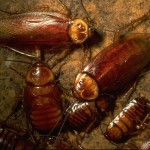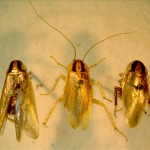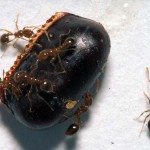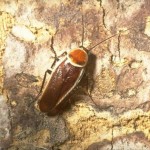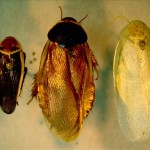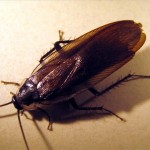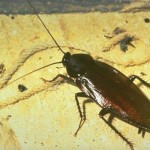View PDF, Extension Publication E-359
Thirty species of cockroaches are known to occur in Texas and, a few of those become noticeable in urban landscapes, including turf and ornamental plantings around homes and other structures (Adkinson1991, Stidham and Stidham 2001).
Cockroaches are a diverse group of insects in the Order Blattodea including the blaberid cockroaches (Family Blaberidae), the wood cockroaches (Family Blatellidae), the blatid cockroaches (Family Blattidae) and the sand cockroaches (Family Polyphagidae). Texas shares many species found in other southern states such as Florida (Koehler and Castner 2003). A few cockroach species are predominantly indoor pests while most species live outdoors for their entire lives. Some species will occasionally migrate indoors from breeding areas where they will be a temporary nuisance or cause undue concern (Gold et al. 2005, and visit: http://urbanentomology.tamu.edu). Some of the most commonly observed cockroaches in Texas landscapes include the Asian cockroach, the American cockroach, the smokeybrown cockroach, the Surinam cockroach, and the Cuban cockroach.
Generalized life cycle
Cockroaches develop through simple metamorphosis (egg cases, nymphal stages or instars, and adult stages are observed). Female cockroaches deposit eggs in batches or cases known as egg capsules or oothecae. Each ootheca contains approximately 15 eggs and is glued or dropped on or around nesting areas. Nymphs hatch from the ootheca and resemble small versions of the adults except they lack fully developed wings and the ability to breed (note that adults of some cockroach species are wingless). Nymphs molt 10 to 13 times in over a year (470 to 600 days, depending on temperature) before becoming adults (Drees and Jackman 1998). Cockroaches are omnivorous, feeding on a variety of materials; some species occasionally may feed on and damage plants.
The Asian cockroach Blattella asahinai Mizukubo (Blattellidae)(Fig. 1), was first detected in the U.S. in Florida in 1986 (Koehler and Tucker 2005). It is an outdoor species very similar in appearance to the indoor species, the German cockroach, Blattella germanica (Linnaeus), (Fig 2) and other Blattella species. They are 1/2 to 5/8 inch long with two dark stripes on the first segment of the thorax (pronotum) behind the head. Asian cockroaches are commonly found in lawns and leaf litter. Adults are strong fliers when disturbed, even during the day, but are particularly active at dusk. They will enter homes and are attracted to lights. They have been found in crops such as cotton and soybeans in south Texas where they may eat the eggs of many insect pests.
The American cockroach, Peripleaneta americana (Linnaeus)(Blattidae)(Fig.3), adults are large (1 ½ inch long) and are recognized by the light brown or yellow margin around the pronotum, the shield or first segment behind the head. It lives in sewers, but often enters the home in search of food and shelter.
The smokeybrown cockroach, Periplaneta fuliginosa (Serville)(Blattidae)(Fig. 4), is also fairly large (1 ¼ inch) and dark-mahogany brown to black in color. It is only active at night and of the outdoor cockroaches, it is one of the most common synanthropic (associated with humans) species in Texas. In the wild, it occurs in tree holes and wood piles but it can be frequently encountered in car ports, garages, out-buildings, and on the exterior of homes.
The Surinam cockroach, Pycnoscelus surinamensis (Linnaeus)(Blaberidae)(Fig. 5), like the Asian cockroach, is a non-native species. Adults are medium-sized (3/4 to 1 inch long) and have a shiny brown to blackish body with golden-colored forewings and markings on the abdomen. The prothoracic shield (covering the thorax) is shiny black, narrowly marked with yellow along the front edge (Suiter and Koehler 2003). This is a burrowing species often found in mulch and compost piles and sometimes associated with bedding plants.
Adults of the Cuban cockroach, Panchlora nivea (Linnaeus)(Blaberidae)(Fig. 5), are medium size (3/4 inch long) and of a striking pale green color, although the immature stages (nymphs) are dark brown. This cockroach species occurs in shrubbery, trees and other plants, under logs and other debris. They are active mainly at night and females are often attracted and fly to porch lights.
Other common outdoor species of cockroaches include other wood roaches such as Parcoblatta species (Blatellidae) and the pale-bordered field cockroach, Pseudomops septentrionalis Hebard (Fig. 5 and 6). The latter species occurs in open or wooded areas and is often seen resting on foliage during the night. Parcoblatta species (Fig. 7) occur mainly in wooded habitats where they can be particularly common. They are most frequently encountered when they are attracted to lights at night.
Management
In most cases, cockroaches in the landscape are a mere curiosity and gardeners may only be interested in their identification. Some people, however, keep cockroaches such as the Cuban cockroach as pets. Cockroach numbers may be kept in check by their natural enemies such as the red imported fire ant and parasitic wasps that attack oothecae (Fig.8). However, when food and shelter are abundant cockroaches may become numerous and create a nuisance. In this case, some population control may be desired. It is much easier to avoid than to control cockroaches: properly screen doors and windows, and seal cracks and other potential entry points to prevent their movement into buildings. Avoid creating harborage areas by disturbing or removing woodpiles or accumulation of other debris. Keeping lights around the home turned off will reduce attraction of flying species to the structure.
In some cases, such as with the Asian cockroach, additional measures such as chemical control may be desired. Residual contact insecticide sprays around the perimeter of structures can be attempted, but they may be ineffective because there are usually too many infested areas in lawns, mulch piles, and wooded areas. Toxic baits applied to infested areas may be another option; however, the Asian cockroach can fly 120 ft. or more in a single bout. Koehler and Tucker 2005 list numerous baits, bait stations, crack and crevice sprays, broadcast and outdoor barrier or surface treatment options to control cockroaches.
Acknowledgments
The author wishes to thank Dr. Carlos Bográn and Dr. Roger E. Gold for their careful review of this manuscript, and Dr. Garland McIlveen for the image of red imported fire ant predation on an oothecae.
Prepared July 2010.
Author
Bastiaan M. Drees, Professor and Extension Entomologist,
Texas AgriLife Extension Service, Texas A&M System
Prepared July 2010
Literature Cited
Atkinson, T. H. 1991. Catalog and atlas of the cockroaches (Dictyoptera) of North America north of Mexico. Miscellaneous publications of the Entomological Society of America — no. 78. 85 pages.
Drees, B. M., and J. A. Jackman. 1998. A Field Guide to Common Texas Insects. Gulf Publishers, Houston, Texas. 359 pp. http://insects.tamu.edu/fieldguide/index.html#blattaria.
Gold, R. E., K. Engler, W. Brown and M. Merchant. 2005. Cockroaches: Recognition and Control. E-359. Texas AgriLife Extension Service, Texas A&M System, College Station, TX. https://agrilifelearn.tamu.edu/publications_details.cfm?whichpublication=54
Koehler, P. G. and J. L. Castner. 2003. Cockroaches. SP87. Entomology and Nematology Department, Florida Cooperative Extension Service, Institute of Food and Agricultural Sciences, University of Florida, http://edis.ifas,ufl,edu/in001.
Koehler, P. G. and C. L. Tucker. 2005. Asian Cockroach. ENY-202. Entomology and Nematology Department, Florida Cooperative Extension Service, Institute of Food and Agricultural Sciences, University of Florida, http://edis.ifas,ufl,edu/mg202.
Stidham, J. A., and T. A. Stidham. 2001 Preliminary checklist of orthopteroid insects (Blattodea, Mantodea, Phasmidea, Orthoptera) of Texas. Insect Mundi 15(1):35-44.
Suiter, D. R. and P. G. Koehler. 2003. Surinam cockroach, Pycnoscelus surinamensis. ENY241. Entomology and Nematology Department, Florida Cooperative Extension Service, Institute of Food and Agricultural Sciences, University of Florida, http://edis.ifas,ufl,edu/mg229.

